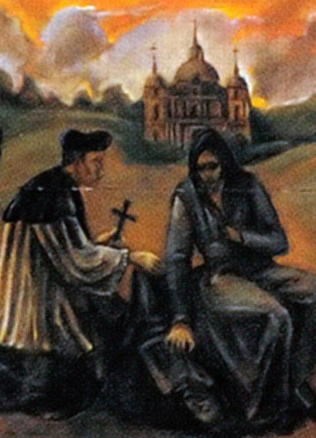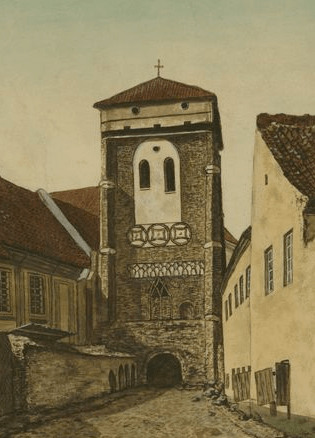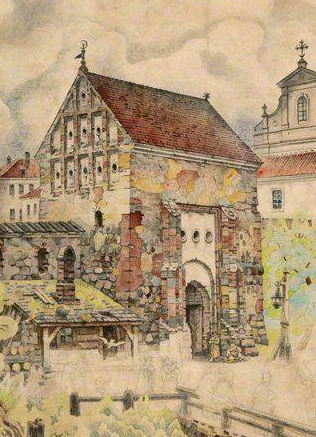The Reconstruction of Barbara Radziwiłł’s Body – a Source of Anthropological Characteristics
The vaults of Vilnius Cathedral house the remains of several sovereigns and noblemen of the Grand Duchy of Lithuania. Special attention was devoted to the burial of Barbara Radziwiłł, the second wife of the Grand Duke Sigismund II Augustus and the Queen of Poland. Her personality and the romantic love story inspired poems, myths, dramatic works and paintings.
The legendary love story
Barbara Radziwiłł was born on December 6, 1520. At the time the Radziwiłł family was the wealthiest and most powerful in Lithuania, holding an impressive list of high offices and grand titles. Her father Jerzy Radziwiłł was Castellan of Vilnius and Grand Hetman of GDL, her brother Mikołaj Radziwiłł the Red held the offices of the voivode of Vilnius, Grand Chancellor of Lithuania and Grand Hetman of GDL and her cousin Mikołaj Radziwiłł the Black was the voivode of Vilnius, Grand Chancellor and Grand Marshal of Lithuania. In 1536 her father concluded an agreement with the Goštautas family, following which Barbara married Albertas Goštautas’ son Stanislovas Goštautas, who died after a short illness in 1542. When Elisabeth, the first wife of Sigismund II Augustus, died in 1545, he started paying frequent visits to Barbara, who lived in the neighbourhood. Soon the visits developed into close relationship and they were secretly married in September 1547. Two months later Sigismund II Augustus sent his pregnant wife to the Radziwiłł estate in Dubingiai and left for Poland expecting to obtain approval of the marriage from his father and the noblemen of Poland. The difficult journey, parting with her husband and the uncertain future had an adverse effect on Barbara’s health and she gave a pre-term birth. On taking over the inherited throne of Poland in 1548, Sigismund II Augustus officially announced his marriage and demanded that Barbara be crowned Queen of Poland. His mother Bona Sforza and the Polish nobility feared domination by the Radziwiłł clan and strongly opposed the marriage, therefore it was only on December 7, 1550 that Barbara Radziwiłł was crowned. After the coronation Barbara got seriously ill and died in Krakow on May 8, 1551. According to her dying wishes, Sigismund II Augustus buried Barbara in Vilnius Cathedral, under the Royal Chapel of the Wołłowicz family.
The mystery of Barbara Radziwiłł’s death. Among the possible versions are poison and venereal diseases.
Even then various rumours and versions circulated about the disease and the cause of death of Queen Barbara. The version spread in popular literature about Barbara having been poisoned under the instruction of Bona Sforza should be dismissed as Barbara’s family, her husband including, never suspected any foul play. The queen had been ill for at least six months before dying and her death was not unexpected. Poisons that would act so slowly were not known at the time and the symptoms resemble other diseases. The version of a venereal disease is also to be rejected as it is hardly possible that the doctors could have failed to diagnose a popular disease of the time – among the medication applied not a single one used to treat syphilis is mentioned. The third version refers to infertility treatment consequences. Of course, Barbara wanted to give Sigismund II Augustus a heir and she took some special measures. Such “treatment” could have caused an infection and internal organ inflammation. The description of the queen’s suffering does not resemble the ordinary course of the disease. The fourth version is a tumour. Today it seems to be the most credible hypothesis. During her illness Barbara was running a fever, she lost weight (despite a good appetite), a wet sore appeared on her stomach, her legs were swollen. Her contemporaries note increased irritability and depression attacks that are characteristic of oncological patients.
Orzechowski chronicles reads: “the Queen died of a severe disease that is called cancer.”
After all, the treatment used (or not used) suggests the possibility of a tumour: it was believed at the time that cancer treatment was pointless and even harmful to the patient. Doctors used patches only and anticipated her rapid death.
Unexpected discovery of the Queen’s remains reveals the historical truth
In the middle of the 17th century the royal remains were hidden for fear of a Russian invasion and the place was forgotten. It was only on the 21st of September 1931 that the remains were found, during the investigation of the foundations of the Cathedral after the flooding of river Neris. In the gothic crypt, the bodies of Alexander Jagiellon, Elisabeth of Habsburg, who was the first wife of Sigismund II Augustus, and Barbara Radziwiłł were resting, with all their royal regalia. Examination and conservation of human remains were conducted by the specialists Michal Reicher and Witold Sylwanowicz from the Institute of Anatomy at the Stephen Báthory University.
They provided a concise and objective description of Barbara Radziwiłł’s remains (“… a round skull of medium massiveness with a flattish face and a narrow nose, normal occlusion, slender body type, rather tall”) avoiding broader generalizations.
Before the second world war a mausoleum was installed under St. Casimir chapel, which is the final resting place of the royal remains. In 2001, to ensure the safety of the remains and to check their condition, the sarcophagus of Barbara Radziwiłł was opened. It provided an opportunity to re-examine her remains and to check the earlier opinions about the condition of her health. The remains were very well preserved; they were glued together in an anatomical order – even the smallest details were in their proper place, which proves that since August 1933, when they had been returned to the crypt, the remains were not moved. No pathology was found in the bones, the tooth wear was not significant, the lower left second molar was carious causing periodontal inflammation. A rather infrequent anatomic variation was established – an extra rib arising from the seventh cervical cerebra.
The size of the bones showed that Barbara Radziwiłł was about 162 cm tall (5-6 cm taller than the average woman at that time and about 3-4 cm shorter than the average woman today). Thus, Queen Barbara was tall for those days, with broad-ish shoulders, narrow hips and a slender waist.
The historical Barbara was not a fragile doll, but a resolute woman
The opening of the sarcophagus enabled a documentary reconstruction of Barbara Radziwiłł’s portrait. It was made by Vytautas Urbanavičius, who followed the method of Mikhail Gerasimov. The reconstruction revealed distinctive features that were not reflected in the well-known idealized portraits of Barbara Radziwiłł: dominating in the face was a distinct nose with a small hump turning the “fragile doll” into an energetic and resolute woman. The hairdo in the reconstruction was selected according to the 16th century fashion, with the Renaissance beret as a finishing touch. In the opinion of Marija Matušakaitė, this documentary portrait bears the closest resemblance to the 16th century miniature which Sigismund II Augustus would always have with him.
The portrait is a documentary, not an artistic reconstruction. Later, it served as the basis for the artistic portrait made by Stanislovas Kuzma.
The anthropological examination contributed to a more comprehensive reconstruction of the historic portrait of Barbara Radziwiłł, one of the most outstanding women of the time: she was a tall, slender lady with distinct facial features, who enjoyed the life of the nobility of the time and who died young of cancer, one of the biggest killers in previous centuries as well as today.
Rimantas Jankauskas



